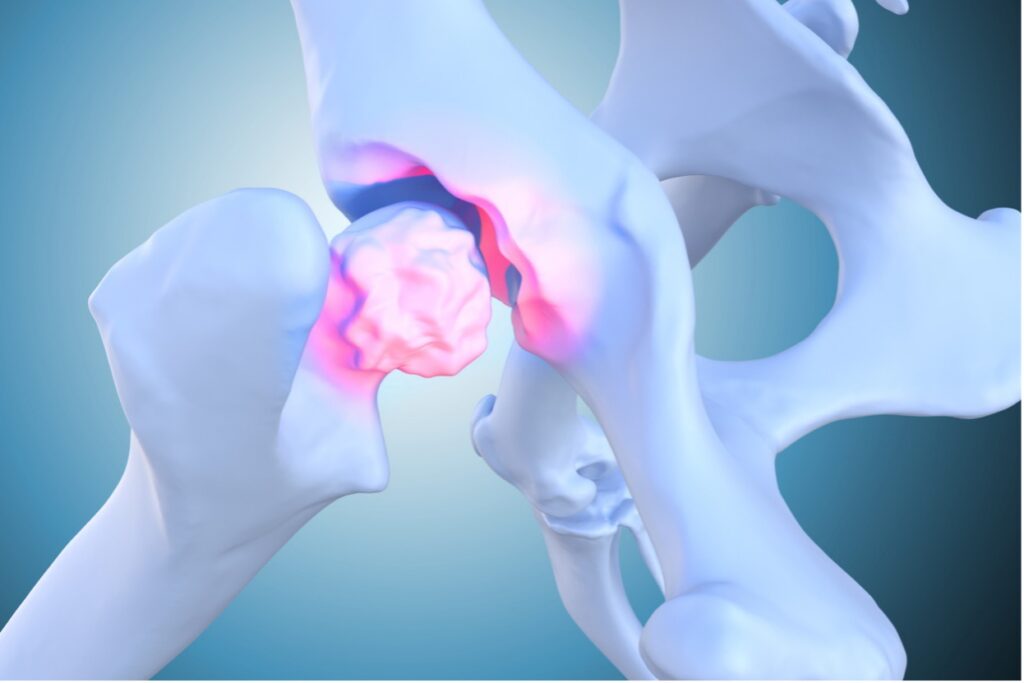At Lenity, we are dedicated to providing advanced veterinary care that enhances the lives of our furry patients. The BioMedtrix Total Hip Replacement (THR) System is among the many innovative treatments we offer. This system is a transformative solution for pets suffering from hip dysplasia and related conditions. We are thrilled to share how this cutting-edge technology improves the quality of life for dogs and cats with hip disease.
Understanding Hip Dysplasia

Hip dysplasia is a prevalent orthopedic condition affecting dogs and occasionally cats. According to the American Veterinarian Medical Association, hip dysplasia is the second most common hereditary disease in dogs. It is second to allergies. It is characterized by abnormal development and degeneration of the hip joint. This malformation leads to instability, inflammation, and eventual joint deterioration, resulting in pain and reduced mobility.
Symptoms of Hip Dysplasia in Dogs and Cats:
Recognizing the signs of hip dysplasia is crucial for early detection and intervention. Common symptoms may include:
- Decreased activity and reluctance to engage in physical exercise.
- Difficulty rising or climbing stairs.
- Limping or favoring one hind leg.
- Stiffness or discomfort when standing or walking.
- Audible clicking or popping sounds coming from the hip joint.
- Noticeable enlargement of the hip joint.
Pet owners must be vigilant and consult a veterinarian if they observe any of these symptoms in their furry companions. Early diagnosis and treatment can significantly improve the pet’s prognosis and quality of life.
Causes of Hip Dysplasia in Dogs and Cats
Both environmental and genetic factors influence a hip dysplasia condition. Certain breeds are predisposed to hip dysplasia.
| Breed | Breed Size | Risk of Hip Dysplasia |
| German Shepherd | Large | High |
| Labrador Retriever | Large | High |
| Golden Retriever | Large | High |
| Rottweiler | Large | High |
| Great Dane | Giant | High |
| Saint Bernard | Giant | High |
| Bulldog | Medium | Moderate |
| Boxer | Medium | Moderate |
| Doberman Pinscher | Large | Moderate |
| Chesapeake Bay Retriever | Large | Moderate |
| Bernese Mountain Dog | Large | Moderate |
| Pug | Small | Low |
| Dachshund | Small | Low |
| Shih Tzu | Small | Low |
| Basset Hound | Medium | Low |
| Cocker Spaniel | Medium | Low |
Some of the cat breeds that have been reported to be predisposed to hip dysplasia include:
- British Short Hair
- Domestic Short Hair
- Maine Coon
- Persian
- Siamese
- Scottish Fold
While certain breeds may predispose dogs or cats to hip dysplasia, individual variation exists within each breed. Not all dogs or cats of these breeds will develop hip dysplasia. Other factors such as genetics, diet, exercise, and environmental influences can also play a role.
Injury or trauma to the hip or leg can accelerate the progression of hip dysplasia and worsen its symptoms by causing additional stress on the already compromised joint. Activities that involve high-impact exercise or repetitive stress on the hip joint, such as jumping or running on hard surfaces, can also contribute to the deterioration of the joint in pets with hip dysplasia.
Diagnosing Hip Dysplasia at Lenity
Diagnosing hip dysplasia typically involves a combination of physical examination, imaging studies, and clinical history evaluation. At Lenity, our experienced veterinarians employ various diagnostic tests to accurately assess and diagnose hip dysplasia in our patients.
- Physical Examination: During the physical examination, our doctors assess the pet’s gait, range of motion, and overall musculoskeletal health. Palpation of the hip joint may reveal discomfort, instability, or abnormal joint conformation.
- Radiographic Imaging: X-rays (radiographs) are essential for evaluating the structure and condition of the hip joint.
- Advanced Imaging: We sometimes recommend advanced imaging such as computed CT scans or MRIs. These images provide detailed anatomical information and assess soft tissue structures surrounding the hip joint.
Once we have confirmed a diagnosis of hip dysplasia, our veterinary team works closely with pet owners to develop a tailored treatment plan that addresses the pet’s individual needs and maximizes the potential for a positive outcome.
The BioMedtrix Total Hip Replacement System
Developed by BioMedtrix, a leader in veterinary implant technology, the BioMedtrix Total Hip Replacement (THR) System represents a significant advancement in pet orthopedics. This state-of-the-art system can effectively restore joint function, alleviate pain, and improves overall mobility for dogs and cats experiencing hip dysplasia and related ailments.
Key Features and Benefits:
- Precision Engineering: The BioMedtrix THR System is engineered meticulously, ensuring optimal fit and function for each patient. At Lenity Vet Specialists, we prioritize precision in every aspect of our practice, and the BioMedtrix THR System exemplifies this commitment to excellence.
- High-Quality Materials: BioMedtrix crafts implants from biocompatible materials such as titanium and cobalt-chromium alloys, renowned for their durability and compatibility with the body’s tissues. These materials promote long-term success and functionality for our patients.
- Minimally Invasive Surgery: Our board-certified veterinary surgeons at Lenity Vet Specialists perform total hip replacement procedures using minimally invasive techniques, minimizing surgical trauma and facilitating faster patient recovery times.
- Enhanced Stability and Mobility: By replacing the damaged hip joint with an artificial implant, the BioMedtrix THR System restores stability, reduces pain, and enhances mobility for pets, allowing them to enjoy a more active and fulfilling lifestyle.
- Long-Term Durability: With proper care and rehabilitation, pets undergoing total hip replacement at Lenity Vet Specialists can experience significant improvements in mobility and quality of life for years to come.
Patient Selection and Rehabilitation:
At Lenity Vet Specialists, we believe in personalized care tailored to each patient’s unique needs. Before recommending a total hip replacement, our experienced veterinary team conducts a comprehensive evaluation, considering medical history, physical condition, and diagnostic imaging results. Ideal candidates for THR typically exhibit advanced hip disease with significant pain and functional impairment despite conservative treatments.
Following surgery, we provide comprehensive post-operative care and rehabilitation support to ensure optimal outcomes for our patients. We work closely with pet owners and their family veterinarians to develop customized rehabilitation plans that promote healing, improve mobility, and enhance the pet’s overall well-being.
Transforming Lives, One Paw at a Time
At Lenity Vet Specialists, we proudly offer the BioMedtrix Total Hip Replacement System as part of our commitment to excellence in pet orthopedics. Through innovative treatments and compassionate care, we strive to improve our furry patients’ lives and support their devoted families. With the BioMedtrix THR System, we’re not just treating hip disease – we are transforming lives, one paw at a time. Trust Lenity Vet Specialists for advanced orthopedic care that puts your pet’s well-being first.
Your Caring Team,

